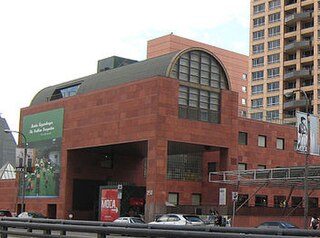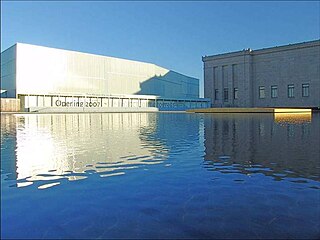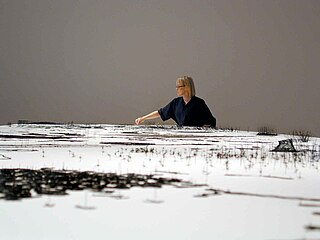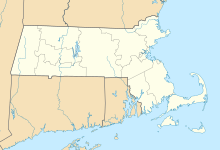
The Isabella Stewart Gardner Museum is an art museum in Boston, Massachusetts, which houses significant examples of European, Asian, and American art. Its collection includes paintings, sculpture, tapestries, and decorative arts. It is originally the home of Isabella Stewart Gardner, whose will called for her art collection be permanently exhibited "for the education and enjoyment of the public forever".

The Museum of Contemporary Art, Los Angeles (MOCA) is a contemporary art museum with three locations in greater Los Angeles, California. The main branch is located on Grand Avenue in Downtown Los Angeles, near the Walt Disney Concert Hall. MOCA's original space, initially intended as a "temporary" exhibit space while the main facility was built, is now known as the Geffen Contemporary, in the Little Tokyo district of downtown Los Angeles. Between 2000 and 2019, it operated a satellite facility at the Pacific Design Center facility is in West Hollywood.

The Nelson-Atkins Museum of Art is an art museum in Kansas City, Missouri, known for its encyclopedic collection of art from nearly every continent and culture, and especially for its extensive collection of Asian art.

The Museum of Contemporary Art (MCA) Chicago is a contemporary art museum near Water Tower Place in downtown Chicago in Cook County, Illinois, United States. The museum, which was established in 1967, is one of the world's largest contemporary art venues. The museum's collection is composed of thousands of objects of Post-World War II visual art. The museum is run gallery-style, with individually curated exhibitions throughout the year. Each exhibition may be composed of temporary loans, pieces from their permanent collection, or a combination of the two.
Mark Cesark is an American sculptor, best known for his use of found and scrap steel.

The Institute of Contemporary Art (ICA) is an art museum and exhibition space located in Boston, Massachusetts, United States of America. The museum was founded as the Boston Museum of Modern Art in 1936 with a mission to exhibit contemporary art. Since then it has gone through multiple name changes as well as moving its galleries and support spaces over 13 times. Its current home was built in 2006 in the South Boston Seaport District and designed by architects Diller Scofidio + Renfro.
Philip Grausman is an American sculptor who continues to push the limits of the time-honored portrait in art.

Mark Tribe is an American artist. He is the founder of Rhizome, a not-for-profit arts organization based in New York City.

Anne Wilson is a Chicago-based visual artist. Wilson creates sculpture, drawings, Internet projects, photography, performance, and DVD stop motion animations employing table linens, bed sheets, human hair, lace, thread and wire. Her work extends the traditional processes of Fiber art to other media. Wilson is a professor in the Department of Fiber and Material Studies at The School of the Art Institute of Chicago.
Jean Shin is an American artist living in Brooklyn, NY. She is known for creating elaborate sculptures and site-specific installations using accumulated cast-off materials.

Jack Wolfe was a 20th-century American painter most known for his abstract art, portraiture, and political paintings.
Stephen DiRado is an American photographer. His work is mostly black-and-white, and he makes frequent use of large-format cameras. He is most noted for his portraiture, night-astronomical photography, and semi-composed group photography, and for the extensive length of his projects.

The Nasher Museum of Art is the art museum of Duke University, and is located on Duke's campus in Durham, North Carolina, United States. The Nasher, along with Dartmouth's Hood Museum of Art and Princeton's Art Museum, has been recognized as a place that "raises the cultural bar" on college campuses.
Rachel Perry is an American artist. She is known for conceptual works using drawing, photography, video, collage, sculpture and performance, which address “the fleeting nature of experience, the elusiveness of desire, and the persistence of objects in a throwaway culture.” Art critic Jerry Saltz has written that her work "not only grappl[es] with consumerism but [she is] just about swallowed whole by it.” Her work also considers themes of gender identity, narcissism, privacy and information overload.
Laylah Ali (born 1968, Buffalo, New York) is a contemporary visual artist known for paintings in which ambiguous race relations are depicted with a graphic clarity and cartoon strip format.

Murray Dewart is an American sculptor best known for his large gate-like structures in granite and bronze. Dewart's sculptures are often created for site-specific locations and installed in parks and gardens. His work is in more than thirty museums and public collections around the world. He is the editor of the Random House anthology Poems About Sculpture.
Meg Webster is an American artist from San Francisco working primarily in sculpture and installation art. While her works span multiple media, she is most well known for her artworks that feature natural elements. She is closely affiliated with Post-Minimalism and the Land Art movement and has been exhibiting her work since 1980.
Craig Stockwell is a visual artist who paints large, colorful, abstract paintings. He currently serves as the Director of the MFA in Visual Arts program at the New Hampshire Institute of Art.
Melvin Joel Zabarsky is an American figurative painter who creates representational work in the narrative tradition. Known for a bright, bold palette, his work often explores political, historical and cultural themes to surreal and realist effect. In a six-decade career marked by several distinct phases, Zabarsky's imaginative use of color, formal experimentation and commitment to narrative organization in both traditional and avant garde styles are hallmarks of his work. In an interview with the British philosophers Donald and Monica Skilling, he said, "I'm discovering history, or a narrative, within a painting, as I go along."

Vanessa Platacis is an American contemporary artist, known for her large scale painting installations. Her interdisciplinary artwork includes painting, installation, and performance art. By combining the history of the decorative arts, architectural design, and pattern, Platacis hand draws and cuts stencils that are used to paint directly onto walls using a variety of spray paint and graffiti techniques. Her work has been featured in galleries and private collections in Boston, Cambridge, Los Angeles, Miami, New Mexico, and France as well as the SCOPE Art Show in Basel, Switzerland. Currently, she lives and works on a sustainable island off the coast of Savannah, GA where she teaches painting at Savannah College of Art and Design.














